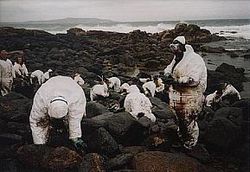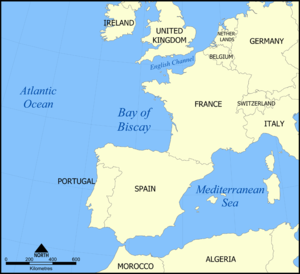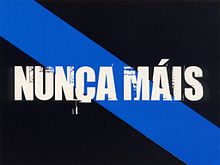- Prestige oil spill
-
This article is about the spill. For the oil tanker, see Prestige (oil tanker).
Prestige oil spill 
Volunteers cleaning the coastline in Galicia in the aftermath of the Prestige catastrophe, March, 2003Location Atlantic Ocean Coordinates 42°53′00″N 9°53′00″W / 42.883333°N 9.883333°W Date 19 November 2002 Cause Cause Hull breach Operator Universe Maritime Ltd. Spill characteristics The Prestige oil spill was an oil spill off the coast of Galicia caused by the sinking of an oil tanker in 2002. The spill polluted thousands of kilometers of coastline and more than one thousand beaches on the Spanish, French and Portuguese coast, as well as causing great harm to the local fishing industry. The spill is the largest environmental disaster of both Spain's history and Portugal's history.
Contents
The Event
The Prestige was a Greek-operated, single-hulled oil tanker, officially registered in the Bahamas, but with a Liberian-registered single-purpose corporation as the owner.
The ship had a deadweight tonnage, or carrying capacity, of approximately 81,000 tons, a measurement that put it at the small end of the Aframax class of tankers, smaller than most carriers of crude oil but larger than most carriers of refined products. It was classed by the American Bureau of Shipping and insured by the London Steam-Ship Owners' Mutual Insurance Association, a shipowners' mutual known as the London Club.
On November 13, 2002, while the Prestige was carrying a 77,000 metric tons cargo of two different grades of heavy fuel oil, one of its twelve tanks burst during a storm off Galicia, in northwestern Spain. Fearing that the ship would sink, the captain called for help from Spanish rescue workers, with the expectation that the vessel would be brought into harbour. However, pressure from local authorities forced the captain to steer the embattled ship away from the coast and head northwest. Reportedly after pressure from the French government, the vessel was once again forced to change its course and head southwards into Portuguese waters in order to avoid endangering France's southern coast. Fearing for its own shore, the Portuguese authorities promptly ordered its navy to intercept the ailing vessel and prevent it from approaching further.
With the French, Spanish and Portuguese governments refusing to allow the ship to dock in their ports, the integrity of the single hulled oil tanker was deteriorating quickly and soon the storm took its toll when it was reported that a 40-foot (12 m) section of the starboard hull had broken off, releasing a substantial amount of oil.
At around 8:00 AM on November 19, the ship split in half. It sank the same afternoon, releasing over 20 million US gallons (76,000 m3) of oil into the sea. The oil tanker was reported to be about 250 kilometers from the Spanish coast at that time. An earlier oil slick had already reached the coast. The Greek captain of the Prestige, Apostolos Mangouras, was taken into custody, accused of not co-operating with salvage crews and of harming the environment.
After the sinking, the wreck continued leaking oil. It leaked approximately 125 tons of oil a day, which polluted the sea bed and contaminated the coastline, especially along the territory of Galicia. The affected area is not only a very important ecological region, supporting coral reefs and many species of sharks and birds, but it also supports the fishing industry. The heavy coastal pollution forced the region's government to suspend offshore fishing for six months.
Cleanup
In the subsequent months, thousands of volunteers were organized with the help of neither the Galician nor the Spanish Government -both belonging to the conservative Partido Popular- to help clean the affected coastline. The massive cleaning campaign was a success, recovering most portions of coastline not only from the effects of the oil spill but also from the accumulated usual contamination. A year after the spill Galicia had more Blue Flags for its beaches (an award for those beaches with the highest standards in the European Union) than in the previous years.
Initially, the government thought just 17,000 tons of oil had been lost, and that the remaining 60,000 tons would freeze and not leak from the sunken tanker. In early 2003, it announced that half of the oil had been lost. Now that figure has risen to about 63,000 tons according to some sources.[citation needed] In 2004 the remaining 13,000 m³ of cargo oil was removed from the wreck, by means of aluminium shuttles and remotely operated vehicles (ROVs). In total, 20 million US gallons (76,000 m3) of oil were spilled.
More than eighty percent of the tanker's 77,000 tons of fuel oil is now thought to have been spilled off Spain's north-west coast.
Experts[who?] predicted marine life could suffer pollution from the Prestige for at least ten years due to the type of oil spilt, which contain light fractions called polyaromatic hydrocarbons. These toxic chemicals could poison plankton, fish eggs and crustaceans, leading to carcinogenic effects in fish and other animals higher in the food chain.
The environmental damage caused by the Prestige was most severe in the coast of Galicia, where local activists founded the environmental movement Nunca Máis (Galician for Never Again), to denounce the passiveness of the conservative government regarding the disaster.
Aftermath
Hull cleanup
In the two years following the sinking, engineers used ROVs to seal cracks in the tanker's hull, now 4000 meters below the sea surface, and slowed the leakage to a trickle of 20 litres a day. By 2004, engineers had removed the oil still in the tanker by drilling of small holes in the wreck, using remotely operated submersible vehicles (ROVs) like the one that originally explored the wreck of the RMS Titanic. The oil was then pumped into large aluminium shuttles, specially manufactured for this salvage operation. The filled shuttles were then floated to the surface. The original plan to fill large bags with the oil proved to be too problematic and slow. After the oil removal was completed, a slurry rich in microbiologic agents was pumped in the hold to speed up the breakdown of any remaining oil. The total estimated cost of the operation was over €100 million.
A recent report by the Galicia-based Barrie de la Maza economic institute[citation needed] criticised the Spanish government's handling of the catastrophe. It estimated the cost of the clean-up to the Galician coast alone at €2.5 billion. The clean-up of the Exxon Valdez cost US$3 billion.
Since the disaster, oil tankers similar to the Prestige have been directed away from the French and Spanish coastlines. The then European Commissioner for Transport, Spaniard Loyola de Palacio, pushed for the ban of single-hulled tankers.
The government was criticized[by whom?] for its decision to tow the ailing wreck out to sea — where it split in two — rather than into a port. World Wildlife Fund's senior policy officer for shipping, Simon Walmsley believed most of the blame lay with the classification society. "It was reported as being substandard at one of the ports it visited before Spain. The whole inspection regime needs to be revamped and double-hulled tankers used instead," he says.[cite this quote] The US and most other countries are phasing out single-hulled tankers by 2012.
Legal Consequences
For the world maritime industry, a key issue raised by the Prestige incident was whether classification societies can be held responsible for the consequences of incidents of this type. In May 2003, the Kingdom of Spain brought civil suit in the Southern District of New York against the American Bureau of Shipping (ABS), the Houston-based international classification society that had certified the Prestige as "in class" for its final voyage. The "in class" status states that the vessel is in compliance with all applicable rules and laws, not that it is or is not safe. On 2 January 2007, the docket in that lawsuit (SDNY 03-cv-03573) was dismissed. The presiding judge ruled that ABS is a "person" as defined by the International Convention on Civil Liability for Oil Pollution Damage (CLC) and, as such, is exempt from direct liability for pollution damage. Additionally, the Judge ruled that, since the United States is not a signatory to the International CLC, the US Courts lack the necessary jurisdiction to adjudicate the case. Spain's original damage claim against ABS was some $700 million.
International maritime trade publications including TradeWinds, Fairplay and Lloyd's List regularly presented the dispute as a possibly precedent-setting one that could prove fateful for international classification societies, whose assets are dwarfed by the scale of claims to which they could become subject.
Investigation
“ The environmental devastation caused is at least on a par, if not worse, than the Exxon Valdez. The amount of oil spilled is more than the Valdez and the toxicity is higher, because of the higher temperatures. ” —Simon Walmsley, World Wildlife Fund's senior policy officer for shipping.[cite this quote]
The massive environmental and financial costs of the spill has resulted in an ongoing inquiry into how a structurally deficient ship was able to travel out to sea, much less approach Spain.
Investigators[who?] have since learned that prior to the spill the Prestige had set sail from St. Petersburg, Russia, without being properly inspected. It traveled to the Atlantic via the shallow and vulnerable Baltic Sea. A previous captain[who?] who complained about numerous structural deficiencies within the ship was rebuffed, and later resigned in protest.
The ownership of the Prestige is unclear, making it difficult to determine exactly who is responsible for the oil spill. Evidence is now pointing to a secretive Greek family who allegedly registered the ship to a front company in Liberia.[citation needed] Thus the Prestige sinking has exposed the difficulties in regulation posed by flags of convenience.
Others[who?] have argued that the Spanish government's refusal to allow the ship to take refuge in a sheltered port was a major contributing factor to the scale of the disaster.
Spanish investigators[who?] have concluded that the failure in the Prestige's hull was entirely predictable and indeed had been predicted already: the Prestige's two sister ships, Alexandros and Centaur, had been submitted to extensive inspections under the "Safe Hull" program in 1996. The organization which was in charge of the inspections, the American Bureau of Shipping, found that both Alexandros and Centaur were in terminal decline. Due to metal fatigue in their hulls, modeling predicted that both ships would fail between frames 61 and 71 within five years. Alexandros, Centaur and a third sister ship, Apanemo were all scrapped between 1999 and 2002. For some reason, however, Prestige was not scrapped, and, little more than five years after the inspection, as predicted, Prestige's hull failed between frames 61 and 71.[1]
Health problems among cleaning staff
Five years later after the cleaning activities, a study found that people participating in the cleaning activities, many of them volunteers, suffered several health problems, such as lung, cardiovascular, and chromosome diseases. This was found among a study of 800 involved Spanish Navy personnel.[2]
Recent developments
In March 2006, new oil slicks were detected near the wreck of the Prestige which investigators found to match the type of oil the Prestige carried. A study released in December 2006 led by José Luis De Pablos, a physicist at Madrid's Center for Energetic and Environmental Research, concluded that 16,000 to 23,000 tons of oil remained in the wreck, as opposed to 700 to 1300 tons claimed by the Spanish government; that bioremediation of the remaining oil failed; and that bacteria corroding the hull could soon produce a rupture and quickly release much of the remaining oil and create another catastrophic spill. The report urged the government to take "prompt" action.[3]
In March[when?], eight years after the instruction of the Prestige case began in the Corcubion Court, UDNG, a small indepedentist Galician Party analyzed some of the main facts in the instruction as an evidence of strong corruption in Spanish judicial system.[4]
See also
- Flag of convenience
- Health crisis
- Manfred Gnädinger
- Manuel Rivas
References
- ^ Mercado, Francisco, El Pais, June 9, 2008, "El fallo estructural que hundió al 'Prestige' era conocido desde 1996", retrieved June 9, 2008 from http://www.elpais.com/articulo/espana/fallo/estructural/hundio/Prestige/era/conocido/1996/elppgl/20080609elpepinac_12/Tes
- ^ Ojea A. Un estudio detecta problemas de salud entre los voluntarios del "Prestige". El Norte de Castilla. 2007/10/02.
- ^ Science, Vol. 314, December 22, 2006, p. 1861.
- ^ http://quilmas.wordpress.com/
- Prestige oil spill far worse than thought, article from New Scientist, August 27, 2003
External links
- Perte totale suite à avarie de coque du petrolier bahaméen Prestige survenue dans l'ouest de la Galice." - Bureau d'Enquêtes sur les Événements de Mer - 13–19 November 2002 (French)
- Plataforma Nunca Máis, Prestige activists (in Galician)
- Coordination Technical Bureau of Scientific Intervention Program against Accidental Marine Spills, This bureau is responsible for management and coordination works of research projects.
- Spill Response Experience Coordination Action - SPREEX This project is responsible for management and coordination research needs in Europe.
- WWF crisis response page on Prestige
- Prestige Oil Spill - first hand story of a Canadian volunteer, with photos
- Maps and statistics of affected costal area
Categories:- Oil spills
- Maritime incidents in 2002
- Shipwrecks in the Atlantic Ocean
- Galicia (Spain)
- Galician culture
- Maritime incidents in Spain
- 2002 in Spain
- 2002 industrial disasters
- 2002 in the environment
Wikimedia Foundation. 2010.


